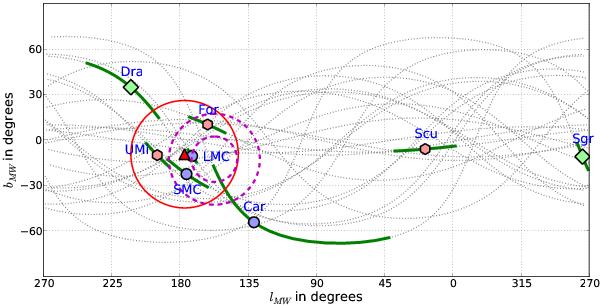Fig. 12

Possible orbital poles (dotted lines) in galactocentric galactic coordinates for the 24 known MW satellite galaxies as defined by their angular positions. For eight MW satellite galaxies proper motions are available, the resulting orbital poles are marked by the symbols. The green lines give the uncertainties in direction of the orbital poles. The red triangle marks the mean direction of the orbital poles of the six satellites close to lMW = 180°, excluding Sagittarius and Sculptor. The red circle marks the spherical standard deviation from this average direction, the dashed circles are the regions 15° and 30° degrees from the normal of the DoS fitted to the 11 classical MW satellites. The data for the orbital poles are taken from Metz et al. (2008). The possible orbital poles (dotted lines) are densest at lMW ≈ 0° and 180°, where they are expected to lie in the case of a rotationally supported DoS. The known satellite orbital poles fall close to these positions with the exception of Sagittarius. A comparison of this plot with the results of particle orbital poles from the numerical calculations in Fig. 4 shows that the orbital poles of the MW satellite galaxies have a similar distribution. There are two distinct populations with an offset of about 180°. The positions of the Draco and Carina orbital poles even hint at a diagonal distribution of orbital poles (elongated from upper left to lower right), similar to the calculated distributions. This shows that the tidal origin model is in agreement with the observations of the MW satellite system. See the on-line edition of the article for a colour version of this figure.
Current usage metrics show cumulative count of Article Views (full-text article views including HTML views, PDF and ePub downloads, according to the available data) and Abstracts Views on Vision4Press platform.
Data correspond to usage on the plateform after 2015. The current usage metrics is available 48-96 hours after online publication and is updated daily on week days.
Initial download of the metrics may take a while.


